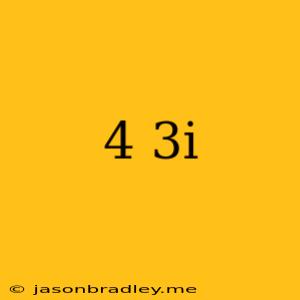Exploring the Complex Number -4 + 3i
In the realm of mathematics, we encounter numbers that extend beyond the familiar real numbers. One such category is complex numbers, which involve the imaginary unit i, where i² = -1. Let's delve into the complex number -4 + 3i and understand its characteristics.
What is -4 + 3i?
-4 + 3i is a complex number expressed in the form a + bi, where 'a' and 'b' are real numbers, and 'i' is the imaginary unit. In this case, the real part (a) is -4, and the imaginary part (b) is 3.
Visualizing Complex Numbers
Complex numbers can be visualized on a complex plane, which is similar to the Cartesian plane. The horizontal axis represents the real part, and the vertical axis represents the imaginary part. Therefore, -4 + 3i would be plotted 4 units to the left of the origin on the real axis and 3 units upward on the imaginary axis.
Properties of -4 + 3i
-
Magnitude: The magnitude or modulus of a complex number is its distance from the origin on the complex plane. It is calculated using the formula: |a + bi| = √(a² + b²). Therefore, the magnitude of -4 + 3i is √((-4)² + 3²) = 5.
-
Argument: The argument of a complex number is the angle it makes with the positive real axis in the complex plane. It is calculated using the formula: θ = tan⁻¹(b/a). In this case, the argument of -4 + 3i is tan⁻¹(3/-4) = -36.87° or 143.13° (depending on the quadrant).
Operations with Complex Numbers
-
Addition and Subtraction: Complex numbers are added and subtracted by adding or subtracting their respective real and imaginary parts. For example: (-4 + 3i) + (2 - i) = (-4 + 2) + (3 - 1)i = -2 + 2i
-
Multiplication: Complex numbers are multiplied using the distributive property and remembering that i² = -1. For example: (-4 + 3i) * (1 + 2i) = (-4 * 1) + (-4 * 2i) + (3i * 1) + (3i * 2i) = -4 - 8i + 3i - 6 = -10 - 5i
-
Division: Division of complex numbers involves multiplying the numerator and denominator by the conjugate of the denominator. The conjugate of a complex number (a + bi) is (a - bi).
Conclusion
-4 + 3i is a complex number with a real part of -4 and an imaginary part of 3. Understanding the visualization, properties, and operations associated with complex numbers is crucial for further mathematical exploration in fields like calculus, linear algebra, and even physics.
